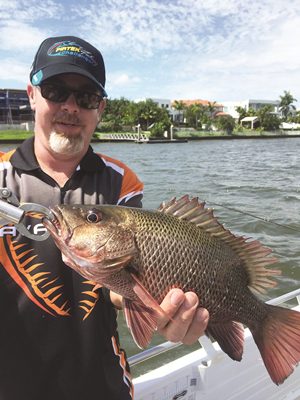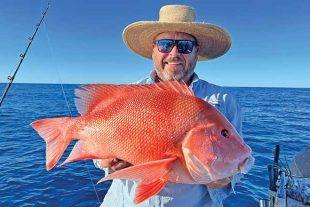




HI everyone, at the time of writing our local rivers had begun to clear after the recent heavy rain events.
The bulk of the fish are in the lower to middle estuary reaches, taking advantage of the feeding opportunity created by the floods flushing baitfish and prawns downstream. This is giving us fun sessions on charters, with a wide variety of fish biting. Good size mulloway, cod, mangrove jack, whiting, flathead, flounder, bream, tarwhine, grunter, trevally, squire and tuskfish are all available.
Mangrove jack will continue to feed aggressively until the water cools in May, when more flathead and tailor turn up. Live yabbies are working very well, as are small blades and vibes in flashy, dark and UV colours. Find the bait balls on the fishfinder and you will find fish. Use live legal size whiting, prawns and mullet for the bigger fish. The trick is timing the tides to make the most of bite periods.
Not enough tidal flow and the fish will be dormant, too much and it’s hard for them to feed and for us to fish. Think like a fish!
April is a great time to be fishing the Gold Coast estuaries. The weather can be unpredictable but we will get some fine days perfect for fishing the Nerang River and Gold Coast Broadwater. I find the Seabreeze website quite accurate with forecasts when planning the next day’s fishing, but I always check the Bureau of Meteorology’s forecasts as well.
If you’re not into lure fishing and just want to get the kids out of the house, head to the southern Broadwater and its huge yabby flats. They can be easily accessed in the last two hours of run-out tides. Just look for the little holes and pump three or four times per hole. Sometimes the better sizes and numbers of yabbies are buried deeper.
One of my favourite ways to fish is wading the Broadwater flats for sand whiting. All you need is a light 1-4kg rod and a 1000 or 2500 size reel filled with 6lb monofilament or fluorocarbon line. Braid is not necessary and makes it harder to retie your rigs during a hot session. You can use a small running sinker on a trace but I prefer no sinker at all, just a size 8 short bait-holder hook.
Pull up to a yabby bank in the last few hours of the run-out tide and anchor just off the edge of the bank. First, hop off with your yabby pump, sieve and bucket and get enough bait for about three to four hours of fishing. Then return to the boat and drop off the pump and sieve. You will need a shoulder bag at this point to make the session easier by keeping your hands free while fishing and unhooking fish. These are available at most tackle shops and the good ones have compartments for a bait box.
Fill it with a mini tackle kit comprising swivels, spare hooks and sinkers, a set of long-nosed pliers, a fish-measuring tape or ruler and the whiting you catch if you’re after a feed. Place a small bait container in the bag and fill it with water and yabbies. Then grab your rod and start hunting. Good polarised sunnies help you spot the fish. Your eyes will become accustomed to seeing the shadows the whiting cast over the sand.
Most of the whiting on the Broadwater flats are in ankle-deep water, so fish with the wind behind you and walk slowly over the top of the bank if it’s covered by water, or just off the edge if it’s dry at low tide. Start by throwing a few yabbies into the water a couple of metres in front of you to call in the fish. You will notice smaller whiting appear first to grab a free meal, with the bigger ones a bit warier. Then grab a yabby and pass the point of the hook just through the underside of the tail and no further.
This way the yabby stays alive and looks more natural. This is further enhanced by using no sinker and fluorocarbon line, which sinks faster than mono. If you spot a bigger whiting, try to gently cast towards that fish and let the yabby sink to the sand by keeping the line slack. A careful, smooth cast is essential to avoid losing the yabby. You can often watch the whiting grab the bait metres from you and take off in a hurry to escape from other fish wanting to steal its food.
Be sure to have your bail arm open when feeling a bite to ensure a good hook-up, and let the fish run for five seconds to ensure a solid hook set. Then flick the bail arm over and slowly lift to set the hook and fight the fish. Whiting go hard in shallow water!
If you’re not getting bites, wade around the beautiful Broadwater flats until you find a school. As the tide starts to run back in, move to the shallowest edge of the water lapping on the bank. The whiting will be there waiting to access the yabby and soldier crab holes. This form of fishing is as relaxing as it gets and very rewarding. Be aware of stingrays as you wade, and be as stealthy as possible so you don’t spook the fish. And of course, adhere to size and bag limits.
For added fun, cast and retrieve surface lures for aggressive strikes from whiting in shallow water less than half a metre deep. Early morning is the best time before the waterways get noisy. The locally made MMD Splash Prawns are great lures for this form of fishing.
To book a charter with Brad or me, or if you have any fishing-related questions, SMS 0432 990 302 or email fishingwithclint@gmail.com
You can also find us on Facebook by searching for Brad Smith Fishing Charters.
 Bush 'n Beach Fishing Magazine Location reports & tips for fishing, boating, camping, kayaking, 4WDing in Queensland and Northern NSW
Bush 'n Beach Fishing Magazine Location reports & tips for fishing, boating, camping, kayaking, 4WDing in Queensland and Northern NSW








